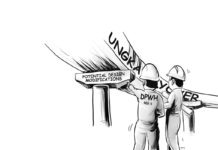
[av_one_full first min_height=” vertical_alignment=” space=” custom_margin=” margin=’0px’ padding=’0px’ border=” border_color=” radius=’0px’ background_color=” src=” background_position=’top left’ background_repeat=’no-repeat’ animation=”]
[av_heading heading=’INTERNATIONAL ILONGGO | What is the OROB? (Part 1)’ tag=’h3′ style=’blockquote modern-quote’ size=” subheading_active=’subheading_below’ subheading_size=’15’ padding=’10’ color=” custom_font=”]
BY JED JALECO DEL ROSARIO
[/av_heading]
[av_textblock size=” font_color=” color=”]
[/av_textblock]
[av_textblock size=” font_color=” color=”]
IF YOU’RE paying attention to events in China then you should be aware of the so-called One Road, One Belt (OROB) initiative which according to some is that country’s biggest bid for superpower status to date.
In practical terms, however, it’s hard to describe exactly what the OROB is. It’s supposed to be a kind of neo-silk road; basically, a massive trade network that will unleash the trading potential of member states from all over Asia, Europe, Africa, and the Middle East.
For the experts, however, the issue is a lot vaguer than what’s actually advertised by China’s state media. For example, Chenggang Xu, professor of economics at the Cheung Kong Graduate School of Business, considers the OBOR as more of a “philosophy” or “party line” rather than anything concrete.
To better understand the underlying motivations behind the OROB, it’s important to remember that China’s economy is overwhelmingly reliant on investment-driven growth.
This growth strategy wasn’t really a problem when China was still in the early stages of development, when there are many opportunities in the Chinese economy. Money flowed into these productive investments and everyone got richer.
Fast forward to today and that is no longer the case. Almost all areas in China are in subprime territory, and the Chinese are struggling to find a solution to their debt problem. Add to this fact the increasing protectionist tendencies in the developed world, and it’s clear that the growth model that China uses is no longer sustainable.
So why does China keep trying to support unsustainable investment policies?
It’s because if they close the financing faucet the gross domestic product (GDP) will start to slow down, and should this happen the Chinese economy will experience all kinds of economic problems, including unemployment, loss of investment confidence or even potentially a crash in various sectors.
Now, what does any of this have to do with the OROB?
The answer is simple: China is trying to export its excess capacity elsewhere, and the OROB is the vehicle by which they intend to do this. China’s planners are hoping that the OROB will be the perfect solution to their economic programs.
The idea is that China’s OROB program will build up infrastructure and trade networks all over Asia, Central Asia, Europe and even Africa to stimulate economic activity among the participating countries. This network will not only offer an alternate land-based logistical supply chain to risky sea-based freights and expensive air-based freights, it will also increase foreign demand for Chinese goods and services, or at least, that’s the idea.
The problem, though, is that the OROB is already showing signs of failure. According to one article on the Economist, one OROB project in Kara Balta, Kyrgystan – an oil refinery – has failed because it couldn’t find sufficient oil to run at more than six percent capacity.
Another example is one Chinese-sponsored coal power plant in Indonesia, which was accused of being over-budgeted. There are also many Chinese OROB-aligned firms in Myanmar that have received various complaints about de-forestation.
Of course, not all OROB projects have failed, and despite all the bad news, there are many success stories as well.
However, no matter how individual projects turn out, they cannot change the PRC’s biggest economic problem, which is China’s slowing and unsustainable growth model. For Xi Jinping and his administration, the OROB is their biggest bet at keeping the Chinese economy stable, but given current trends all over the world that may not be possible.
Global trade will see many disruptive changes in the coming years, and some, like automation for example, could make massive intercontinental supply chains for manufactured good obsolete.
Add to this Increasing protectionism, decline of human capital, terrorism and many other problems, and it’s easy to see how China’s OROB is more of a desperate gamble than an optimistic opportunity. (jdr456@gmail.com/PN)
[/av_textblock]
[/av_one_full]



